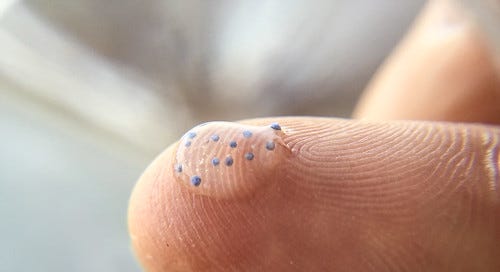Did you know that many of the cosmetics you use daily contain microplastics—tiny plastic particles less than 5 millimeters in size? Often marketed as "microbeads," these bead-shaped plastics are a clever branding choice by the cosmetics industry,. "Microbeads" sounds far more appealing than "micro-plastic particles" when selling beauty products, after all. While not technically misleading, the term adds a touch of polish to what is essentially plastic pollution in disguise.
Microplastics, often in the form of microbeads, are commonly used in products like facial scrubs, body washes, and toothpastes, often replacing natural alternatives like crushed nutshells or salt. Beyond exfoliation, microplastics serve various functions, such as thickening formulations or improving texture. These cost-effective plastic ingredients sometimes make up as much as 90% of a product’s composition.
Microplastics have been found everywhere, in every nook and cranny of the planet, in the air, oceans, rivers, clouds, and the water we drink. They have been detected in food items like seafood, sea salt and bottled drinks (please avoid buying and drinking bottled water.) It is virtually impossible to avoid them. Little wonder, therefore, that microplastics have been detected throughout the human body, including in the blood, saliva, liver, kidneys, placenta, penises and even breast milk.
Needless to say that plastic, including microplastics, are a growing environmental and health challenge, and their impact is far from benign. Plastic pollution is increasingly being recognised as a threat to planetary boundaries, a concept introduced to define the limits within which humanity can operate safely without causing irreversible environmental damage.
MIT’s Biodegradable Breakthrough
In a promising development, MIT researchers have now developed biodegradable materials designed to replace microplastics, such as these plastic beads in your beauty products. These materials break down into harmless sugars and amino acids, offering an eco-friendly alternative to traditional microplastics. With a grand form Estée Lauder, the team is conducting further testing and plans to start human trials in the coming months.
Is this going to solve the problem?
Not really. While this innovation could significantly reduce microplastic pollution from specific sources, it’s not a comprehensive solution to the broader issue of microplastics pollution. Microplastics originate from various sources, including the breakdown of larger plastic debris, synthetic textiles, and industrial processes.
Moreover, the environmental behaviour and ecological impact of biodegradable microplastics are complex and not yet fully understood. Some studies suggest that biodegradable plastics may still pose environmental risks under certain conditions, as their degradation can be influenced by various environmental factors.
In conclusion, a truly effective response requires a comprehensive strategy, including:
Regulating Single-Use Plastics: Introducing caps on new plastic production, such as limiting production to 2020 levels, could help curb the proliferation of plastics.
Holding Polluter Accountable: (Polluter Pay Principle) Implementing extended producer responsibility (EPR) frameworks to hold manufacturers accountable for the lifecycle of their products.
Unfortunately, international progress has been incredibly slow. Just last month countries failed to reach agreement in UN plastic talks. The reason?
Major oil-producing nations, notably Saudi Arabia and Russia, opposed measures of capping plastic output, advocating instead for a focus on waste management and recycling.
Translation? They’re happy for us, the consumers, to shoulder the blame—again. It's not their sprawling petrochemical industries that fuel the plastic crisis; it's our failure to recycle. Convenient, isn't it?"
Thank you for reading this Substack. If you think someone else might enjoy this too, please spread the word. If you have any feedback, please comment below.
Sources and further reading:
Patricia Villarrubia-Gómez, Bethanie Carney Almroth, Marcus Eriksen, Morten Ryberg, Sarah E. Cornell., Plastics pollution exacerbates the impacts of all planetary boundaries, One Earth, 2024, https://doi.org/10.1016/j.oneear.2024.10.017
Anne Trafton, A new biodegradable material to replace certain microplastics, MIT News, 6 December, 2024, https://news.mit.edu/2024/new-biodegradable-material-could-replace-certain-microplastics-1206
Zhengyin Piao, Amma Asantewaa Agyei Boakye & Yuan Yao , Environmental impacts of biodegradable microplastics, Nature, 27 September, 2024,
International Campaign Against Plastic in Cosmetics - Beat the Microbead





Thank you for sharing this. I hope we find a solution for microplastics on a scale that is truly going to make a difference. As a “consumer” there is only so much you can do it seems.